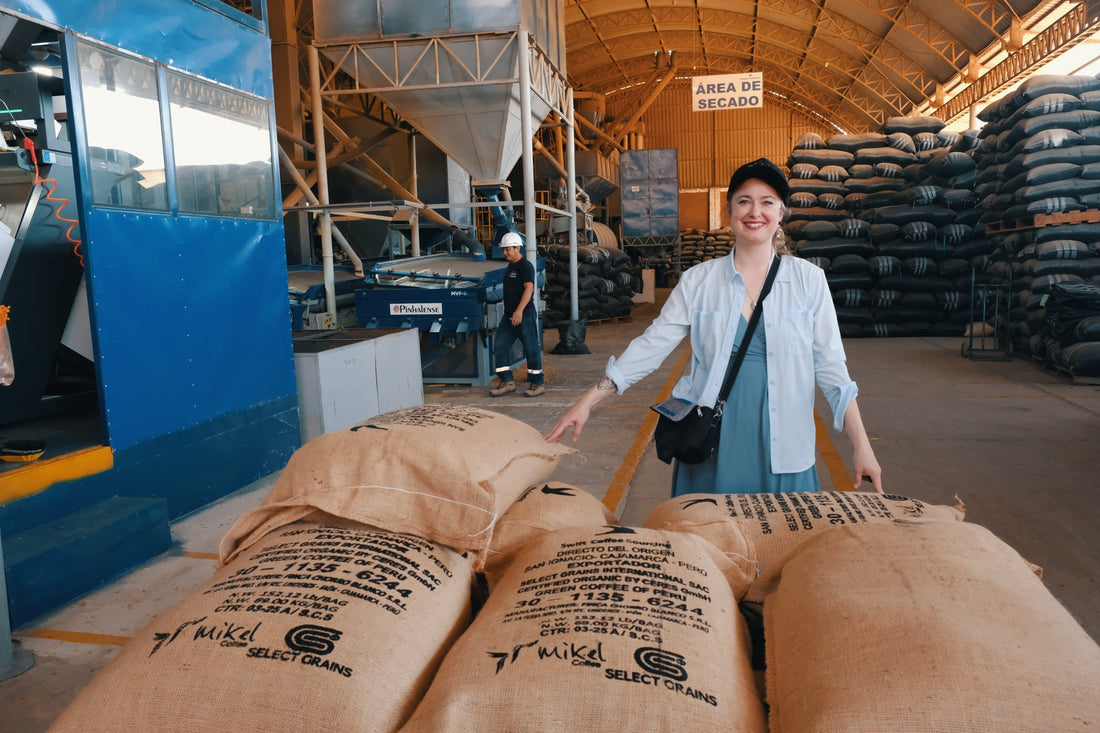
A Case Study in Sold-Out Coffee
Share
Rather to my surprise, I sold a full container (280 sacks) of our new house brand, Estrellas de Cajamarca, in just six hours last Friday. Email & social notification went out around noon and by evening, I was disappointing a lot of roasters. I could have sold another full container that afternoon if I had it.
I haven’t had such an intense sales day since the early times of Catalyst (say 2017-2019), when it was just Michael and me sourcing, marketing, selling, and releasing Ethiopian coffees, and we would land nearly every container at 92%+ sold.
It was exhilarating, wild, and exactly the win this new business needed.
I thought it might be meaningful to dig under the surface a little around why exactly the coffees flew off the virtual shelf like that.

Beautiful coffee cherries this August (2025) in Cajamarca.
Pricing is (almost) everything
The C market closed at $3.78/lb on Friday August 22.
This lot of Estrellas de Cajamarca was priced at $4.60/lb Ex-works Oakland—TARIFFS INCLUDED.
Yeah, I’d have bought it all up too.
I’d have signed an SAS-NANS contract without even thinking about it.
And 84+ point coffee with notes of chocolate cream pie, clover honey, and sweet tea, from one of the most well-known and loved areas of Peru, landing next week?
Um, yes please, sign me up and I’ll throw in a pisco sour.
But why was I able to sell a volume-based coffee at $4.60 a pound, which is just a differential of +82?
Timing rules the (green coffee trading) world
I contracted that container back when the C dipped below $3. It was at $2.98/lb the day we fixed it. I’d been watching the market (I use futures.coffee for that btw, and I don’t like what it’s telling me today) and had everything queued up to fix the moment we hit that milestone. One of my clients fixed an entire box of this type of coffee when the C Market was at $2.84, and I tip my hat to him.
Since my costs were predicated on a lower C price, I could choose to sell it at its replacement cost (C of $3.78 + whatever diff, likely a +160 or so for spot buyers including tariffs) or I could choose to simply sell it at a sensible margin for that contract, taking the quick win.
My priorities at this early stage for Swift made the decision for me.
Priorities influence pricing
I have very clear priorities for Swift right now.
Avoiding the kinds of risks which I’ve intimately experienced in past green coffee businesses, my goal is to establish Swift’s high-quality customer base as quickly as possible while building our product line and industry reputation for 2026 (when we plan to break even) and 2027 (when we have even bigger plans).
As well, finance is a constraint as it is for nearly every new business in a cash-intensive product, and even more than grasping for a big margin win, I need to recycle or churn my cash. Having buyers lined out, especially buyers who take the coffee immediately, means that I am able to unlock significant lines of credit in the near future, making 2026 purchasing much less of a headache.
And, I wanted to introduce our Estrellas de Cajamarca product line with a bang to buyers. How better than to make it accessible in this moment of arbitrage? This coffee is great, and next year I expect it will make up 50% of our volume or thereabouts. It’s the kind of coffee a roaster can build an entire program around: stable, consistent quality from a reliable supply chain. Making it possible for roasters to access it now, experimenting with substituting it for Brasil (since everything is insane for North American roasters right now), opens the door for us to bring actual volume to the table with our producing partners. It moves the needle.
 Our coffee being processed for export, August 2025
Our coffee being processed for export, August 2025
About Brasil
When Trump announced his 50% tariffs for Brasilian coffee a couple months ago, it shocked us all. For the coffee world this has a HUGE impact, almost impossible to state the ripple effects. I’ll let the economists and the commentators handle that, but for us, working in Peru, it’s a moment of opportunity which I want to handle tenderly.
Yes, I have Brasil replacements in my lineup.
Yes, this is extremely positive for the producers I work with, and for Swift.
Yes, I think that Peruvian coffee is an excellent substitution for Brasilian coffee, especially when you spend the time to learn the profiles, defect counts, and processing methodologies which unlock a lower-acid, chocolate-and-nuts forward profile. And in future we will be leaning into providing that exact profile to North American roasters.
But I have always felt strongly that we need to be gentle when taking opportunities like this, because there are real producers missing out on the other side. And I never want to encourage my roaster partners to treat them as if they are replaceable.
I have benefitted so intensely from roasters who are loyal to their supply chain partners. As the green coffee world is so brutal, so high-risk and so sharky, having buyers who see me and my producer partners as people and value us accordingly—giving us great communication and keeping their commitments—has been life-changing.
So yes, I know that part of why this container of coffee sold out so quickly was because of the unfortunately tariff allocation to Brasil, but I’m not rejoicing over that.
A quick note about SAS contracts
How did the coffee sell that quickly?
Roasters initiated SAS-NANS contracts with Swift to hold the coffee pending a sample approval.
SAS-NANS stands for Subject to Approval of Sample, No Approval No Sale and is a useful mechanism for roasters to lock in coffees with their importers while they wait to get a sample they can roast, cup, and evaluate.
The truth is that an SAS contract leaves the risk squarely on the importer’s books, but it’s better than nothing. Importers that don’t focus on QC or specialize in sourcing can find they have a lot of buyers executing their rejection clause (and FYI if a roaster does that too often, they might have trouble getting SAS contracts) which isn’t fun for anyone.
However the sourcing organizations I run are always very focused on the product, and we have had almost zero rejections over the years.
I’m completely comfortable writing SAS-NANS contracts especially for Estrellas de Cajamarca because if a roaster rejected it, I could sell it with a couple phone calls based on the demand I saw Friday.
As well, an 84ish point coffee for $4.60 is kind of crazy these days. I doubt there will be any rejections from this container.
Did you miss out on Estrellas at $4.60?
If you are in the substantial list of roasters who were interested in Estrellas de Cajamarca and didn’t speak up fast enough to initiate an SAS contract, please don’t stress about it. Assuming the C goes down a bit, I’m planning to buy another box or two, and try to keep the price accessible still. So keep watching our communications on that because obviously the moment I write the contract with our Peruvian partners, I’ll be looking to sell it here in the USA.
And if you didn’t know about Estrellas, please put it on your radar.
This is the first of Swift Coffee Sourcing’s house brands: a lovely 84+ point Peruvian washed Gr. 1 coffee, certified and uncertified, with those beautiful chocolate, honey, and tea notes. It’s created to stand up beautifully in blends or as a Single Origin, and it is sourced from the exceptional producing groups I’ve worked with for a decade. We also buy microlots from these folks, so it’s a really special way to work intentionally in this origin.
I’m creating a waitlist for the next batch of Estrellas. Send me a quick note to let me know you’d like to be notified before the general public and I’ll add you to it! Beautiful Cajamarca coffee fields.
Beautiful Cajamarca coffee fields.
